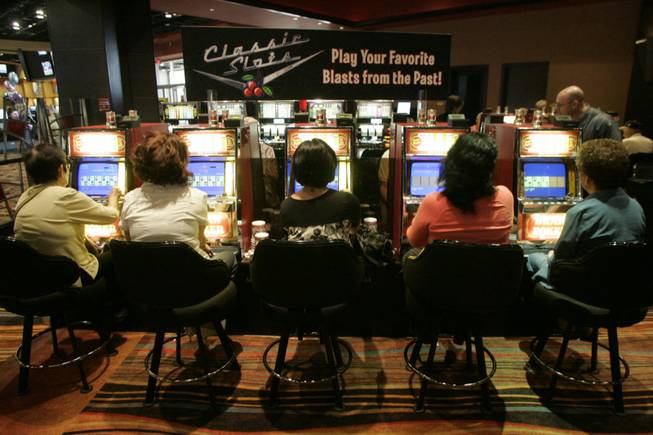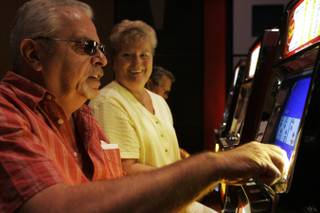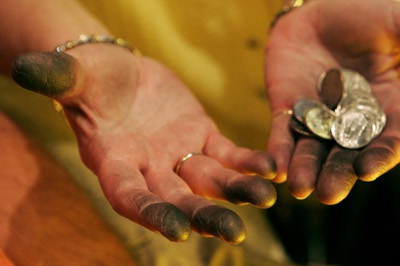
The coin slot area at Eastside Cannery is one of the most popular parts of the casino, especially with those nostalgic for the trappings of vintage Las Vegas.
Tuesday, April 20, 2010 | 2 a.m.
Sun Archives
Map of Eastside Cannery
Like other casinos, the Eastside Cannery on Boulder Highway tries to keep players coming back by installing the latest and most elaborate slot machines on the market.
Yet the chairs in front of most of these glittering towers were empty on an afternoon last week, their noises and lights playing to a sparse crowd.
It’s a common scene in recession-plagued Las Vegas, where casinos are lucky to fill even half of their seats with gamblers — which makes the sights and sounds near a side entrance of the Eastside Cannery all the more unusual.
In a room off the main casino, gamblers occupy every available chair in front of a bank of red boxes that look more like small, box television sets than like modern slot machines. There are no blinking lights or animated images, only lighted glass with the words “Draw Poker” and a blue screen with images of five cards.
But the noise from these machines really sets them apart.
Modern slot floors are a rumble of recorded sounds, electronic soundtracks, voices captured from movies and television shows.
But the machines attracting the attention on this day have their own sound: the loud pinging of quarters hitting metal trays and the clink of coins as gamblers scoop them up and drop them, one by one, into the machines.
It’s the sound of old Las Vegas, resurrected.
Coin-operated slot machines have mostly been phased out of American casinos in the past several years. The Eastside Cannery is one of the first modern casinos in the country to install machines from the 1980s in an effort to appeal to older players.
It’s not that the machines couldn’t be found in Southern Nevada for those who were willing to hunt them down. The Gold Strike in Jean, for example, prides itself on using only coin slots — 32 miles south of Las Vegas. But in the valley, fewer than 20 casinos, all older properties that opened with coin slots, offer machines that accept and spit out quarters. They’re the leftover machines. Their ranks decline as casinos sell off aging slots in favor of digital ones that play faster and, in theory, make more money for casinos.
That assumption didn’t necessarily hold true at Eastside Cannery, however. The casino opened in 2008 with a bank of the Draw Poker machines — known as Fortune 1 to gambling enthusiasts — near its cashier cage. The machines were recycled from the Nevada Palace, torn down to make way for the new casino — but they were obviously popular.
“We wondered why these games were full when we’ve got all the latest and greatest games out there on the floor,” Eastside Cannery General Manager Marty Gross says. “And they were always full.”
So the casino bought more, along with a few other coin-operated machines that are no longer made. The games would get a new home near the main entrance, in a space formerly occupied by a high-limit slot room that got little use even when the economy was strong.
Like their vintage appearance, the names of these games are as basic as gambling gets: Deuces Wild, Jokers Wild, Double Diamond and Triple Diamond. A bank of “Humpback Keno” machines, their blue screens like small robotic eyes, are encased in a giant hunk of brown metal that looks out of place next to the tall, fancy games scattered about the casino.
The 56-machine “Classic Slot Room” has been a hit since it opened last month, Gross says.
“As much as people would like to think these are all in a graveyard somewhere, these machines are still out there,” he says. “And there are people who want to play them” — especially in the casino’s neighborhood, one of the oldest in Las Vegas.
Among the players is Judy Cantrell, who moved to Las Vegas in 1992 and played coin machines at Nevada Palace until it closed in early 2008.
“These are the first games I ever played,” Cantrell says. “I like the interaction that comes with using coins. You’re not just pressing a button.”
Cantrell, 68, waited up to two hours for a chance to play the Fortune 1 machines when the casino had fewer of them on the floor.
“I was here at 11 p.m. the other night and I waited 45 minutes for a machine,” she says. “Sometimes we’ll come in on a Sunday at 6 a.m. and play a little, then get some breakfast. A lot of people who come here are retired so you just take your chances as far as when you’ll get a machine.”
Although the rest of the casino is lucky to have 40 percent of its machines occupied on any given day, the coin-operated slots get used more than 60 percent of the time, Gross says.
The machines are part of an effort by the casino to offer unique attractions that help it stand out. Eastside Cannery is in the most competitive casino market in suburban Las Vegas with more than a half-dozen casinos — and two long-established giants on Boulder Highway nearby.
In the old days, casinos were constantly draining and refilling machines with coins, as well as removing jammed coins and fixing other mechanical problems. For some, gambling was a grimy, labor-intensive process involving coins that blackened hands after hours of play and filled heavy coin buckets.
For 62-year-old Patsy Hale, that just makes it “more fun,” she says as she dips her hands into a bucket brimming with gleaming quarters in the Classic Slot Room.
Her husband, Jerry Hale, 64, has a more practical point of view.
“You lose your money slower playing these machines. That’s why I like ’em,” he explains.
The 20-year residents rattle off the names of casinos they have visited. All of them, such as Jerry’s Nugget and Skyline, still have a few coin-operated machines. Some, such as the Stardust, are gone.
The coin slots at Eastside Cannery “are the only reason we come here,” Jerry Hale says.
The sound of coins hitting trays, a noise carefully cultivated by manufacturers that perfected the engineering of metal and angle for the most pleasing jingle possible, is still a big part of the attraction for many players, says Anthony Curtis, publisher of Las Vegas Advisor.
“Whenever we ask people what they miss about old Las Vegas, they always bring up the coin machines,” Curtis says.
In the late 1990s, players gravitated toward coinless machines with bill acceptors and paper tickets for convenience and faster play. The change benefited casinos that were replacing older, simpler machines. At first, removing coins from the equation was a significant enough drawback for players that manufacturers compensated by building coinless slots with metal trays embedded with speakers emitting the sound of falling coins.
Over time, players became accustomed to faster digital machines that used advanced software for bigger jackpots and a higher frequency of small jackpots. More advanced machines had home entertainment features such as high-definition images, bucket seats and surround sound.
Casinos say gamblers shouldn’t expect to see many more coin-operated machines because the majority of players prefer high-tech machines.
Station Casinos, the largest operator of suburban casinos, offers only ticket machines.
“We have not yet seen a demand by our guests for the return of coin-operated slot machines,” spokeswoman Lori Nelson says.
Boyd Gaming offers coin-operated machines at its three downtown Las Vegas casinos and Sam’s Town, just up the road from Eastside Cannery.
“We have a certain portion of our players who still prefer the coin machines, but we have no plans to introduce more of them,” spokesman David Strow says. The coin machines are “exceptionally popular” with those who play them, he adds.
They’re also a big draw at El Cortez, which has one of the largest stashes of coin machines.
To General Manager Mike Nolan, these 230 or so machines are like antique cars: hard to find in good condition and more difficult to maintain.
“A lot of our employees have been here a long time, so they’re still knowledgeable about the machines,” Nolan says. “We have mechanics who have spent 20 years working on them.”
In the past couple of years, the casino has snapped up 12 coin slots to add to its inventory.
Older gamblers are more comfortable playing them, Nolan said. Some are skeptical of the new devices and how they operate, he says.
Fortune 1’s manufacturer, slot giant International Game Technology, no longer makes coin-operated slots, although it refurbishes and sells old coin machines from its Las Vegas plant.
American casinos have little use for these vintage games, but foreign ones do, says Ron Brooks, IGT vice president of gaming service and operations.
The coin machines, taken back from casinos that buy newer machines just like old cars traded in for new models, are shipped to places such as South Africa and Peru.
Nations newer to gambling lack the software and systems to support the latest machines, so it’s easier and more affordable for them to go low-tech, Brooks said.
Although his company has moved beyond coin slots, Brooks is happy to hear that the games of his youth are still in use.
They remind him of his first trip to Las Vegas in 1982, when he gambled at the Aladdin.
“I was planning to play blackjack. I played these Fortune 1 machines instead and loved them.”
Coin machines aren’t for everyone, of course.
Just ask Donovan York, Eastside Cannery’s director of slot operations and a former slot manager at the Rampart in Summerlin.
Coin slots probably wouldn’t work at the Rampart, he says, because “people on that side of town don’t like to get their hands dirty.”



Join the Discussion:
Check this out for a full explanation of our conversion to the LiveFyre commenting system and instructions on how to sign up for an account.
Full comments policy